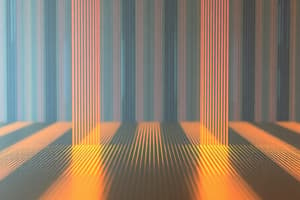Podcast
Questions and Answers
What is the primary cause of dark fringes in a double-slit experiment?
What is the primary cause of dark fringes in a double-slit experiment?
- Destructive interference (correct)
- Refraction of light
- Constructive interference
- Reflection of light
Which formula calculates the position of dark fringes in a double-slit experiment?
Which formula calculates the position of dark fringes in a double-slit experiment?
- sinθ=mλ/a
- sinθ=(m+1/2)λ/d (correct)
- sinθ=(m+1/2)λ/a
- sinθ=mλ/d
In the formula y_m = mλL/d, what does d represent?
In the formula y_m = mλL/d, what does d represent?
- Slit width
- Distance from slit to screen
- Distance between slits (correct)
- Wavelength of light
What happens to the fringe spacing y_m if the wavelength λ is increased?
What happens to the fringe spacing y_m if the wavelength λ is increased?
What is the effect of increasing the distance d between slits in a double-slit setup?
What is the effect of increasing the distance d between slits in a double-slit setup?
Which property of light is demonstrated by the creation of bright and dark fringes?
Which property of light is demonstrated by the creation of bright and dark fringes?
What is the order m of the central bright fringe in a double-slit experiment?
What is the order m of the central bright fringe in a double-slit experiment?
What does the angle θ represent in the equations for interference and diffraction?
What does the angle θ represent in the equations for interference and diffraction?
How is the position of bright fringes calculated in a double-slit setup?
How is the position of bright fringes calculated in a double-slit setup?
What happens to fringe spacing if the distance between the screen and slits L is doubled?
What happens to fringe spacing if the distance between the screen and slits L is doubled?
What kind of light is most commonly used in double-slit experiments to observe interference patterns?
What kind of light is most commonly used in double-slit experiments to observe interference patterns?
If the slit width is decreased in a single-slit experiment, what happens to the central maximum?
If the slit width is decreased in a single-slit experiment, what happens to the central maximum?
What is the role of λ in the equation y_m = mλL/d?
What is the role of λ in the equation y_m = mλL/d?
What condition must be met for constructive interference in a double-slit setup?
What condition must be met for constructive interference in a double-slit setup?
What adjustment will increase the number of observable fringes in a double-slit experiment?
What adjustment will increase the number of observable fringes in a double-slit experiment?
Which of the following statements is true regarding fringe spacing y_m in a double-slit experiment?
Which of the following statements is true regarding fringe spacing y_m in a double-slit experiment?
For a single-slit diffraction pattern: If the slit width a is halved, which of the following is correct?
For a single-slit diffraction pattern: If the slit width a is halved, which of the following is correct?
Which of the following numerical relationships is correct for the second-order dark fringe in a single-slit diffraction setup where a=0.05 mm, L=2.0 m, and λ=650 nm?
Which of the following numerical relationships is correct for the second-order dark fringe in a single-slit diffraction setup where a=0.05 mm, L=2.0 m, and λ=650 nm?
Which of the following adjustments will result in no visible interference pattern in a double-slit experiment?
Which of the following adjustments will result in no visible interference pattern in a double-slit experiment?
Given a single-slit diffraction pattern with slit width a=0.1 mm and wavelength λ=500 nm, which of the following values for θ corresponds to the first-order minimum?
Given a single-slit diffraction pattern with slit width a=0.1 mm and wavelength λ=500 nm, which of the following values for θ corresponds to the first-order minimum?
Flashcards
Dark Fringes in Double-Slit
Dark Fringes in Double-Slit
Dark fringes in a double-slit experiment are formed by destructive interference of light waves.
Dark Fringe Equation
Dark Fringe Equation
sinθ = (m + 1/2)λ/d, where θ is the angle, m is the order, λ is the wavelength, and d is the slit separation.
Slit Separation (d)
Slit Separation (d)
The distance between the two slits in a double-slit experiment.
Fringe Spacing (ym)
Fringe Spacing (ym)
Signup and view all the flashcards
Increased Wavelength Effect
Increased Wavelength Effect
Signup and view all the flashcards
Increasing Slit Separation
Increasing Slit Separation
Signup and view all the flashcards
Interference and Diffraction
Interference and Diffraction
Signup and view all the flashcards
Central Bright Fringe Order
Central Bright Fringe Order
Signup and view all the flashcards
Angle θ in Interference/Diffraction
Angle θ in Interference/Diffraction
Signup and view all the flashcards
Bright Fringe Calculation
Bright Fringe Calculation
Signup and view all the flashcards
Increased Screen Distance Effect
Increased Screen Distance Effect
Signup and view all the flashcards
Monochromatic Light
Monochromatic Light
Signup and view all the flashcards
Decreased Slit Width (single-slit)
Decreased Slit Width (single-slit)
Signup and view all the flashcards
Wavelength's Role (ym)
Wavelength's Role (ym)
Signup and view all the flashcards
Constructive Interference Condition
Constructive Interference Condition
Signup and view all the flashcards
Increasing Screen Distance Effect
Increasing Screen Distance Effect
Signup and view all the flashcards
Fringe Spacing Proportionality
Fringe Spacing Proportionality
Signup and view all the flashcards
Halving Slit Width (single-slit)
Halving Slit Width (single-slit)
Signup and view all the flashcards
No Interference Pattern Condition
No Interference Pattern Condition
Signup and view all the flashcards
Study Notes
Double-Slit Experiment
- Dark Fringes: Caused by destructive interference.
- Dark Fringe Formula: sinθ = (m + 1/2)λ/d, where:
- θ is the angle of the dark fringe.
- m is the order of the fringe (an integer).
- λ is the wavelength of light.
- d is the distance between the slits.
- d (in the formula): Represents the distance between the slits.
- Wavelength Increase: Increases the fringe spacing (ym).
- Slit Separation Increase (d): Causes fringes to move closer together.
- Bright Fringe Calculation: sinθ = mλ/d , where m is the fringe order
- Central Bright Fringe: Order m = 0.
- θ (angle): Represents the diffraction angle.
- Bright Fringe Position Calculation: sinθ = mλ/d, m is the fringe order
- Screen Distance Increase (L): Causes a doubling of fringe spacing.
- Light Source: Monochromatic light is used for clear interference patterns.
- Single-Slit Diffraction: Decreasing slit width (a) increases the width of the central maximum.
- λ (in the formula): Represents the light wavelength.
Interference Conditions
- Constructive Interference: Path difference = mλ, where m is an integer.
- Increasing Screen Distance: Increases the number of observable fringes.
- Fringe Spacing (ym): Directly proportional to λ and L, inversely proportional to d.
- Single Slit Diffraction Pattern and Slit Width Change: If the slit width is halved, the central maximum width doubles.
Single-Slit Diffraction
- Slit Width and Central Maximum: Decreasing slit width increases the central maximum width.
- First-Order Minimum Conditions: This is linked directly to the angle θ associated with this order, as well as the wavelength λ of light used and slit width a.
- Minimizing Interference Patterns: Increasing the slit width to be greater than the wavelength results in no visible interference pattern.
Studying That Suits You
Use AI to generate personalized quizzes and flashcards to suit your learning preferences.



